Waist to height ratio WHtR
Waist to height ratio calculator
Summary
Main Content
Main Content
How to measure waist circumference
Acquire a flexible measuring tape or tape rule. Feel for your hip bone and your bottom rib, and place the tape measure evenly around your waist which is halfway between the last rib and hip bone. The waistline may lie directly above your umbilicus. (If needed, use a mirror to guide the tape straight around your waist and parallel to the ground.) Record the value in centimeters.How to measure height
A tape measure, a flat surface, and a pencil are needed. Stand with your feet without shoes flat on the floor with your heels against the corner where the wall and floor meet. Ensure your head, shoulders, and buttocks touch the wall. Look straight ahead parallel to the floor. Have someone place a book or a ruler over your head and lightly mark the wall with a pencil. Then measure the distance between the marked point and the floor. Record the value.Main Content
🎥 Video tutorial:
How to use the waist to height ratio calculator
Learn how to measure waist to height ratio using our easy-to-use waist to height ratio calculator. Unlike
regular tools, it gives visual and color-coded results to clearly show health risk levels. Backed by
world-class research results and perfect for both children and adults, it's a smarter alternative to BMI.
Calculate
Waist to height ratio calculator
/
=
0
Result interpretation
Obesity is a chronic relapsing disease of excess fat accumulation (adiposopathy) but not excess weight. To limit the stigma associated with obesity, we propose a new nomenclature of overweight as adiposopathy grade 1 (high fat) and obesity as adiposopathy grade 2 (excess fat).
Benefits of using waist to height ratio calculator over body mass index (BMI)
Waist to height ratio (WHtR) had a very high agreement of 81 – 89% with DEXA-measured total body fat mass and trunk fat mass, but a low agreement with muscle mass (24 – 39%). BMI had a moderate agreement with total fat mass and trunk fat mass (65 – 72%) and muscle mass (52 – 58%). Since BMI had a moderate agreement with DEXA-measured muscle mass, it is difficult to specify whether BMI measures excess fat or muscle mass. The optimal waist to height ratio cut points that predicted the 95th percentile of total fat mass in males was 0.53 and 0.54 in females. This cut point detected 8 out of 10 males and 7 out of 10 females who truly had excess DEXA-measured fat. The cut point also identified 93 out of 100 males and 95 out of 100 females who truly do not have excess fat.
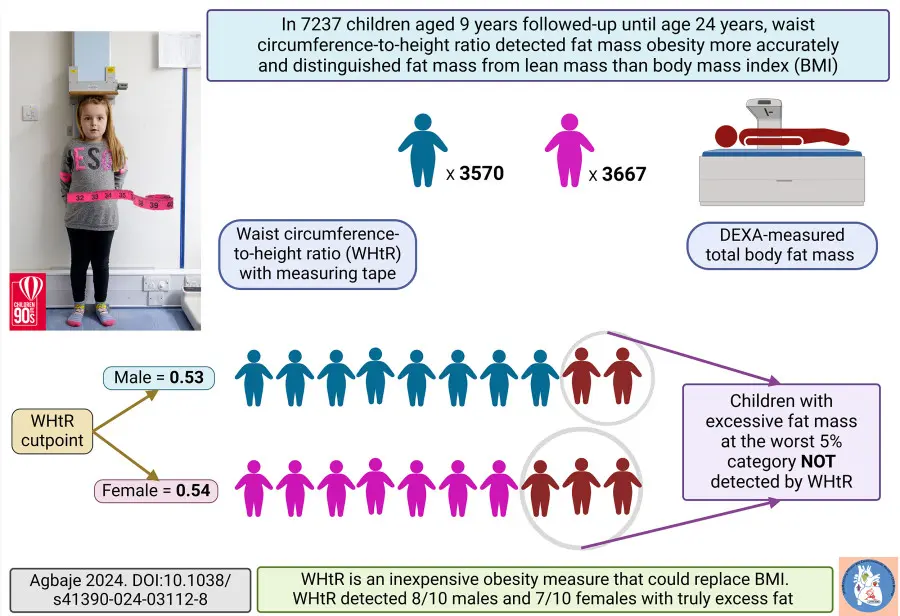
Measuring tape wrapped around a waist to demonstrate how to use the waist to height ratio calculator (WHtR)
“This study provides novel information that would be useful in updating future childhood obesity guidelines and policy statements. The average waist to height ratio in childhood, adolescence, and young adulthood is 0.45, it does not vary with age and among individuals like BMI. Waist to height ratio might be preferable to BMI assessment in children and adolescent clinics as an inexpensive tool for detecting excess body fat or abdominal fat. Parents should not be discouraged by the BMI or weight of their children but can inexpensively confirm whether the weight is due to increase in excess fat by examining their kid’s waist to height ratio.” says Andrew Agbaje
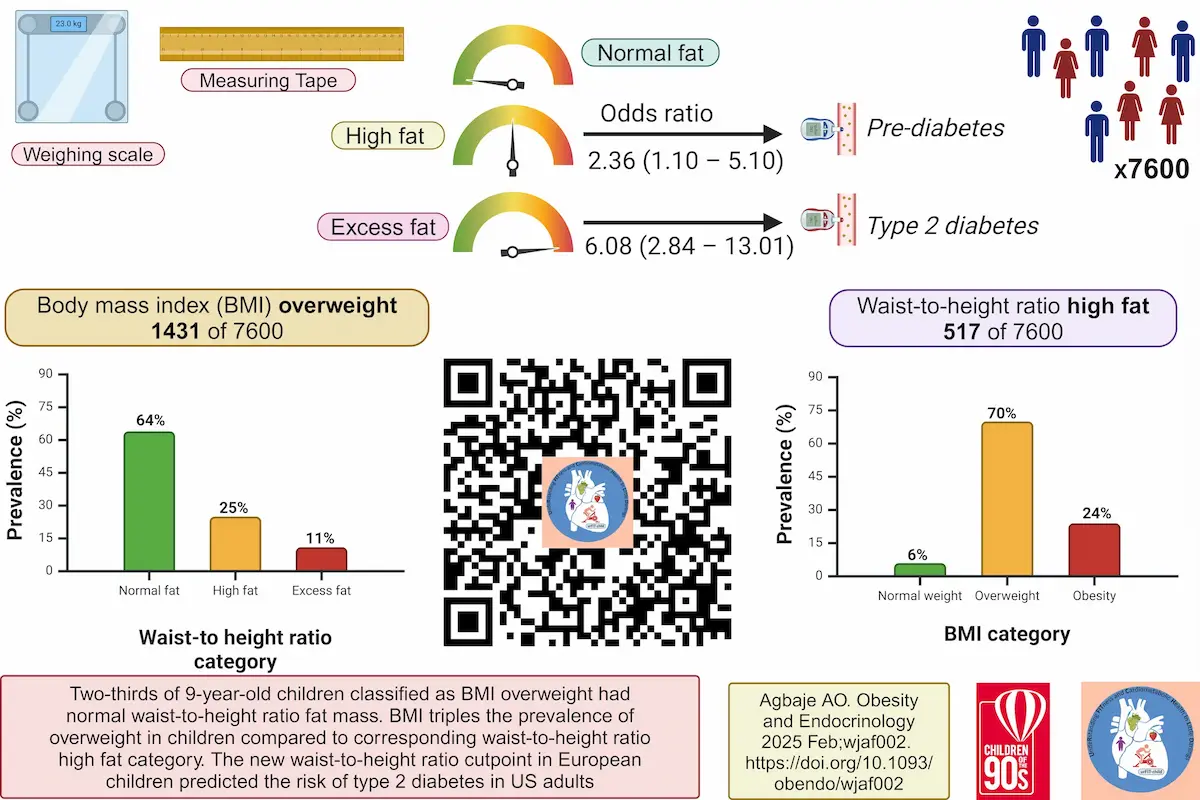
Visual comparison of waist to height ratio (WHtR) categories vs BMI categories for assessing body fat.
"Please do not diagnose overweight and obesity in children and adolescents with body mass index (BMI) alone. BMI was NEVER designed to detect obesity in an individual. Kindly use the waist to height ratio calculator to confirm if the body size is due to fat mass or if the children are simply heavy due to muscle mass.
— Prof. Andrew Agbaje
Health implications
Our team and other researchers across the globe have shown that waist to height ratio (whtr) is a significantly better predictor of type 2 diabetes, heart failure, fatty liver diseases, liver fibrosis/cirrhosis, hypertension, and bone fracture risks than BMI.
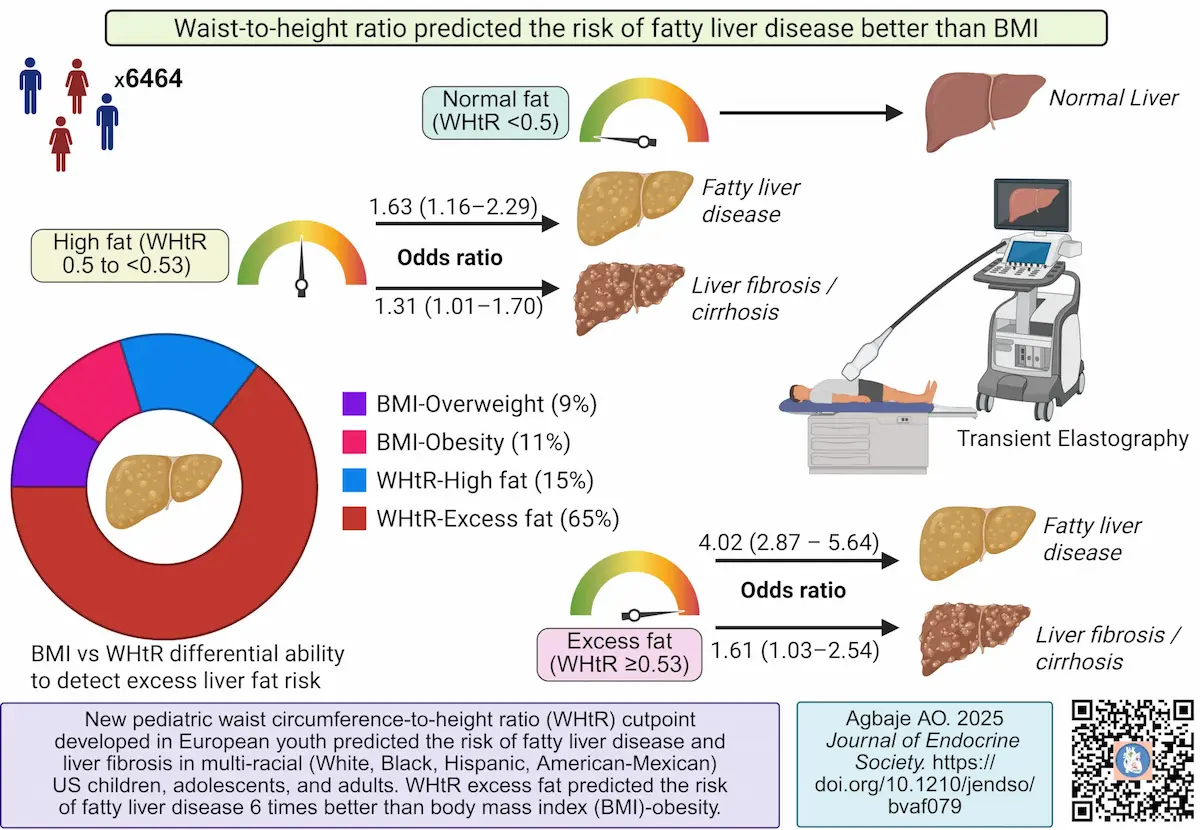
Waist to height ratio calculator (WHtR) helps assess liver disease risk better than BMI, based on recent pediatric health research.
These research findings provide evidence that children, youth and adults with normal BMI but with high or excess waist to height ratio (whtr) estimated fat mass are at risk of several cardiometabolic diseases. This is because waist to height ratio is a specific tool for detecting adiposity (excess fat) and is the most affordable and universally available tool for early detection, screening, diagnosis and management of excess adiposity (obesity) and its related complications.
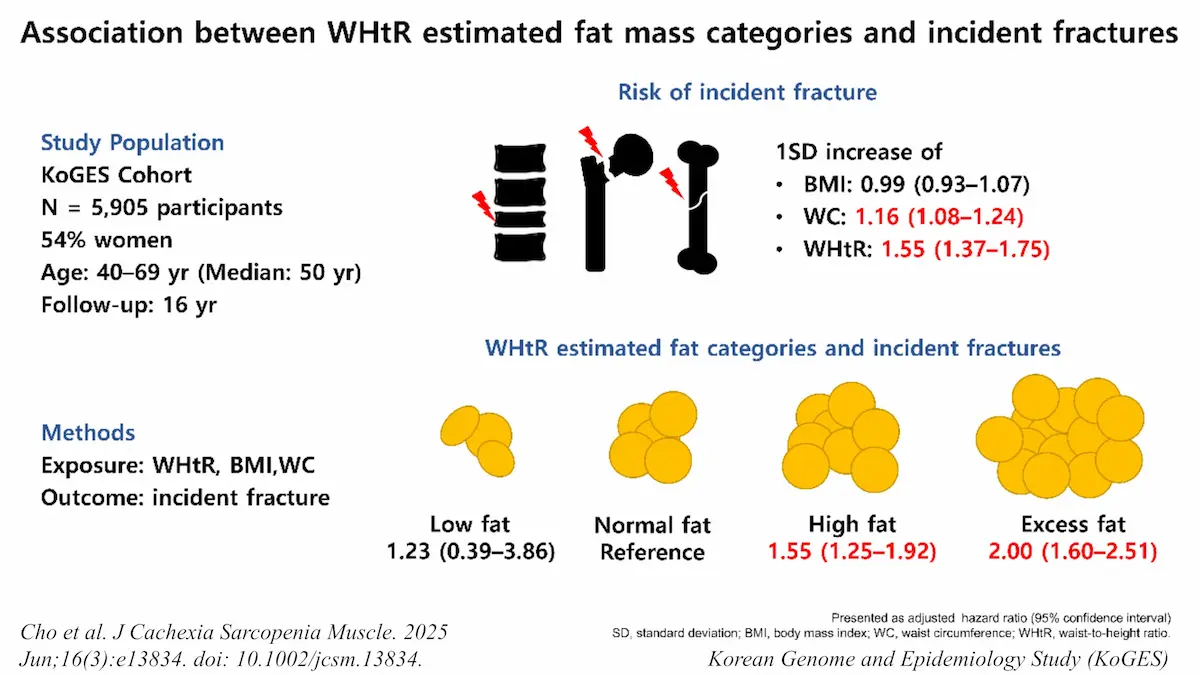
Fracture risk linked to WHtR categories: Study shows how the waist to height ratio calculator can help predict incident fractures through fat mass assessment.
Emerging consensus expert statements (European Association for the Study of Obesity and the Lancet Commission) have strongly recommended that obesity should not be diagnosed in adults with BMI alone but must be confirmed with waist-to-height ratio. There is no consensus statement yet in the paediatric and young adult population.
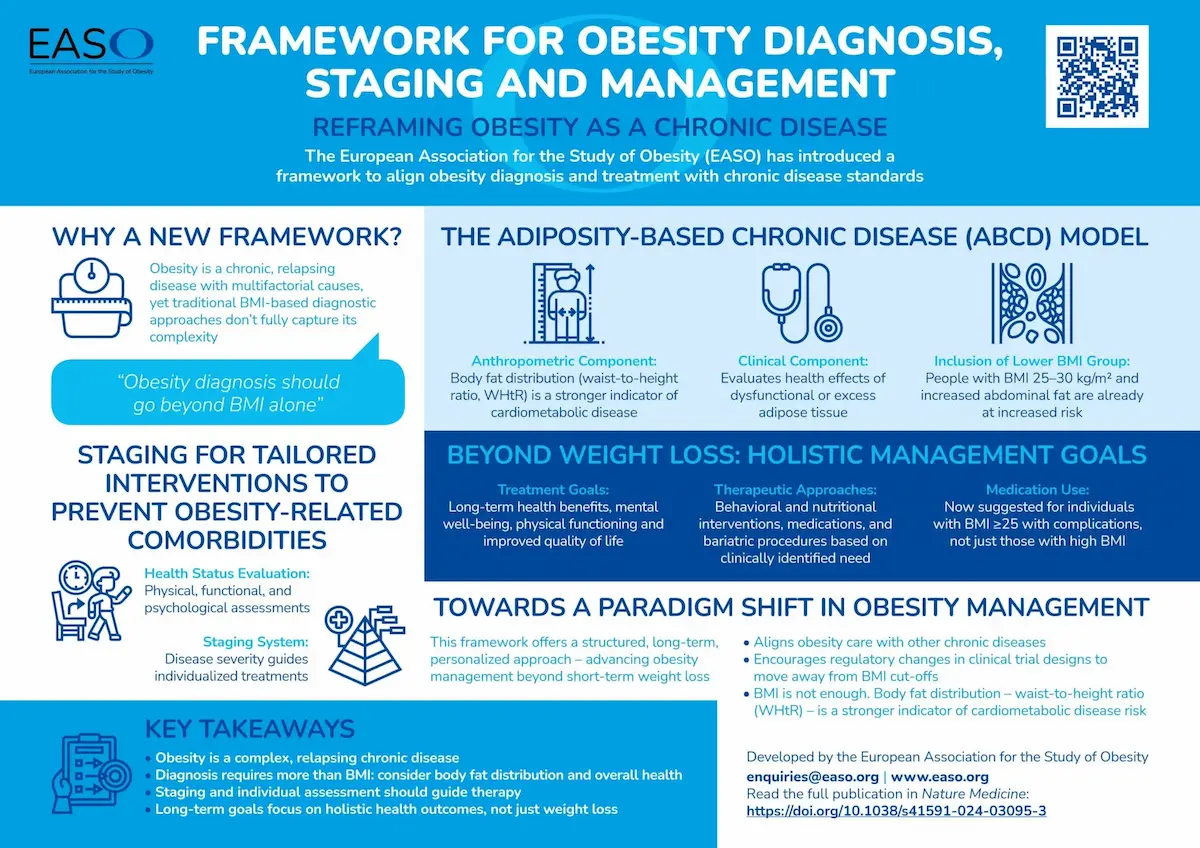
Obesity diagnosis and management framework: WHtR-based waist to height ratio calculator supports improved staging and clinical decision-making.
The European Association for the study of Obesity infographic summarizes the health implications of obesity in males and females.
Male
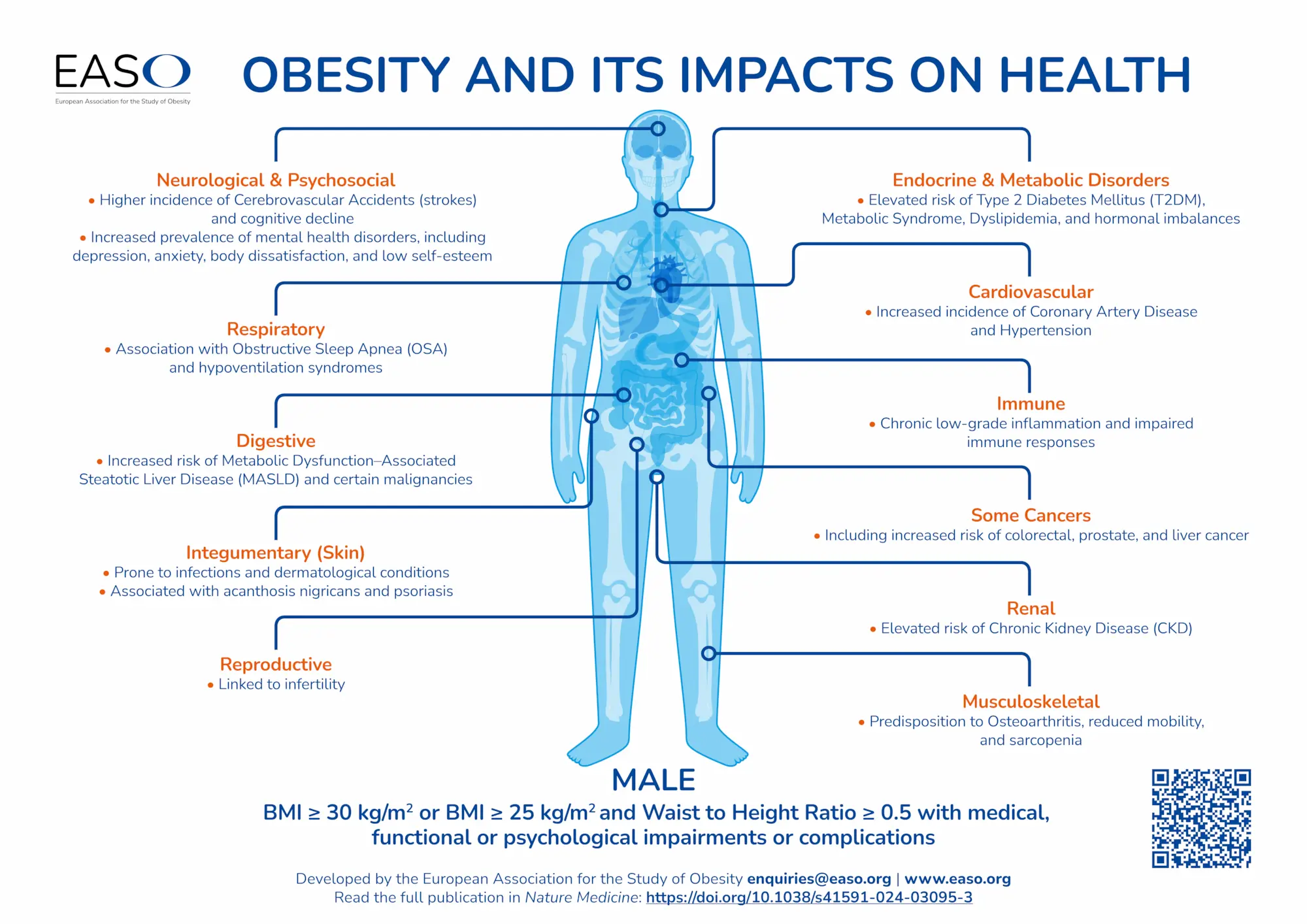
Male obesity and its health impact shown through the waist to height ratio calculator’s visual indicators.
Female
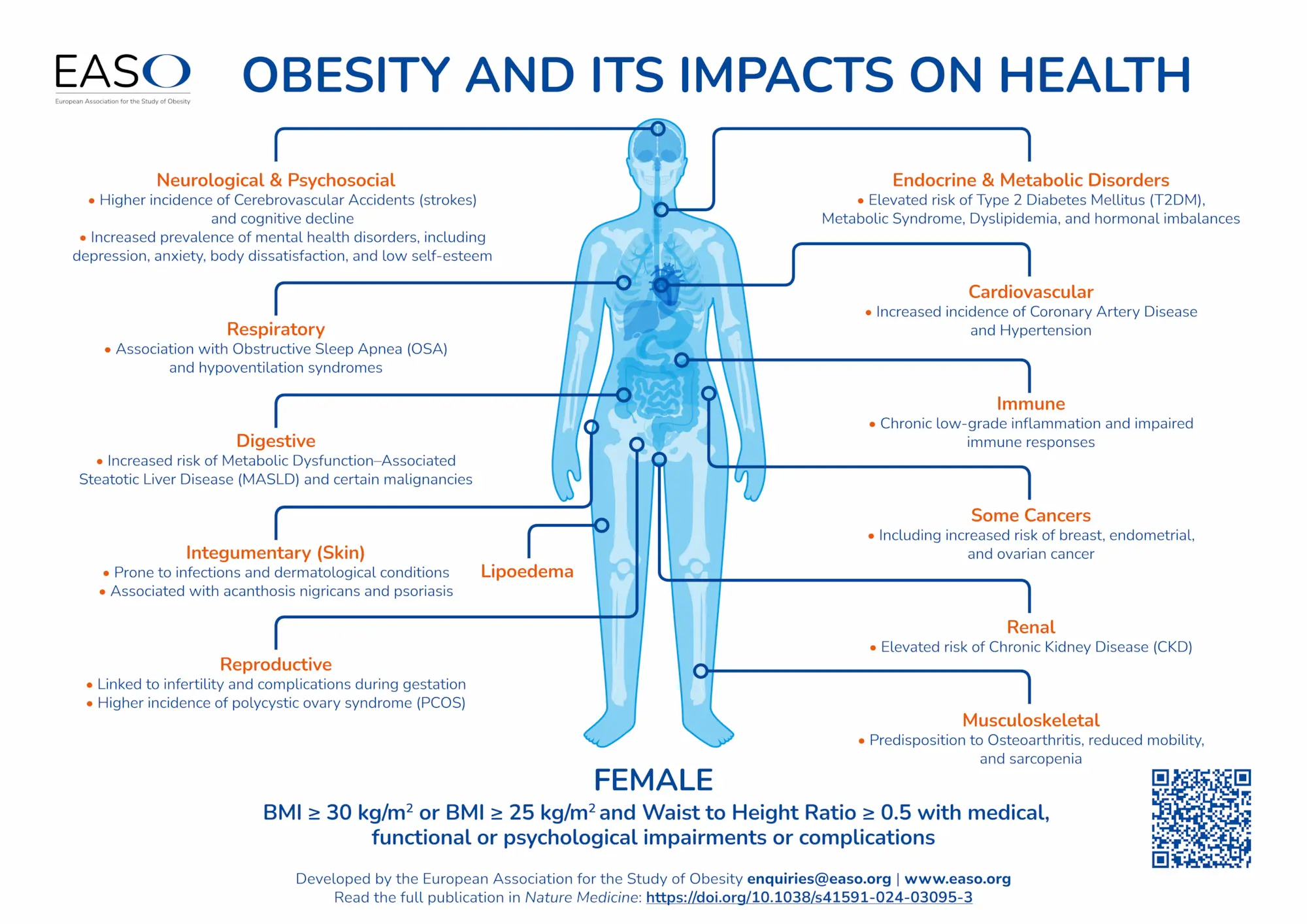
Female obesity and its health impact shown through the waist to height ratio calculator’s visual indicators.
Tips for maintaining a healthy WHtR
Tips for maintaining a healthy waist to height ratio (whtr) below 0.5 for males and 0.51 for females
1. Monitor regularly: Know your waist to height ratio (whtr) today and recheck once in 3 months.
Regular monitoring of your waist-to-height ratio provides valuable insights into your body composition changes over time. Quarterly assessments help track progress and identify trends early, enabling timely adjustments to your health strategy.
2. Stay consistent: If within normal range, continue a healthy lifestyle.
Maintaining a healthy WHtR below 0.5 (males) or 0.51 (females) indicates optimal body fat distribution. Consistency in healthy habits is key to preserving this beneficial ratio and preventing future health complications.
3. Eliminate toxins: Stop drinking alcohol and smoking cigarette (combustible and non-combustible).
Alcohol and tobacco products significantly contribute to abdominal fat accumulation and metabolic dysfunction. Eliminating these substances reduces inflammation, improves metabolism, and supports healthy weight distribution.
4. Stay active: Break sedentariness with at least 3 hours of daily light physical activity.
Prolonged sitting increases visceral fat accumulation. Incorporating light activities like walking, stretching, or household tasks throughout the day boosts metabolism and promotes fat burning, particularly around the waist area.
5. Rest well: Sleep adequately for >7 hours daily.
Quality sleep regulates hormones that control hunger, metabolism, and fat storage. Insufficient sleep disrupts cortisol and insulin levels, leading to increased abdominal fat accumulation and elevated WHtR.
6. Hydrate properly: Drink adequate volume of water >3 litres/daily.
Proper hydration supports metabolic processes, reduces water retention, and helps control appetite. Adequate water intake enhances fat metabolism and can help reduce waist circumference measurements.
7. Choose wisely: Avoid sugary drinks and beverages.
Sugar-sweetened beverages are rapidly absorbed and preferentially stored as abdominal fat. Eliminating these drinks reduces caloric intake and prevents insulin spikes that promote visceral fat accumulation.
8. Reduce processed foods: Significantly reduce high salt intake and processed foods.
Excessive sodium causes water retention and bloating, artificially increasing waist measurements. Processed foods often contain hidden sugars and unhealthy fats that contribute to abdominal weight gain.
9. Cook at home: Cook your own meal and reduce fries and fast foods.
Home-cooked meals allow portion control and ingredient selection, reducing hidden calories and unhealthy fats. Fast foods are typically high in trans fats and calories that preferentially accumulate around the waist.
10. Eat natural: Increase daily portion of vegetables and fruits.
Fiber-rich vegetables and fruits promote satiety, support healthy digestion, and provide essential nutrients while being naturally low in calories. They help maintain stable blood sugar levels and reduce cravings for processed foods.
11. Time your meals: Avoid late and heavy night meals before bed.
Consuming large meals close to bedtime can disrupt digestion, leading to poor nutrient absorption and increased fat storage. Eating earlier in the day allows for better digestion and reduces the risk of abdominal fat accumulation.
Frequently Asked Questions
What is the youngest age to use this waist to height ratio calculator?
Age 5 years.
What is the oldest age to use this waist to height ratio calculator?
>80 years of age.
What do I do when child’s BMI is high?
Confirm with a waist to height ratio (whtr) to identify if this is due to heavy muscle mass or fat mass.
What do I do when child’s waist to height ratio (whtr) is high?
Contact health nurse and request for referral to paediatric endocrinologist for further guidance.
Why is the UK NICE guideline recommending waist-to-height ratios cut point of 0.5 to 0.6 as an indicator of high adiposity in children and adolescents?
These cut points were adopted for ease of memorization and related to cardiometabolic health risks among adults. This is not a statistically and scientifically valid approach for deriving cut points. In addition, waist to height ratio (whtr)s cut point of 0.6 are very rare among children but is common among adults who have significantly higher fat mass than kids. Future update of the UK NICE guideline may incorporate new and emerging evidence on this topic.
Can this waist to height ratio (whtr) cut point be used in Africa, Asia, and South America?
Yes, the new cut point has been validated among major ethnic groups across the globe and it is universally accurate across all continents in the world for predicting cardiometabolic health risks. This is a significant advantage over BMI which varies significantly with age, sex and ethnic groups.
Do males and females have the same waist to height ratio (whtr) cut point?
No, among children and adolescents, females naturally have slightly higher fat mass than males. The waist to height ratio (whtr) cut point for high fat mass in females is 0.51 and that for males is 0.50.
When should the waist to height ratio (whtr) calculator be avoided?
In children <5 years old, during pregnancy, if growth disorder or condition that affects height has been diagnosed, in the presence of eating disorder, and in the presence of abdominal swelling caused by kidney, liver or heart failure.




